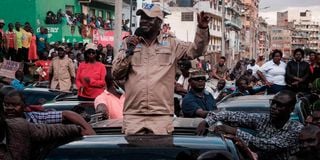Raila Odinga rediscovers his mojo as he leads protests in Nairobi

Raila Odinga (centre), the leader of the Kenyan opposition coalition “Azimio la Umoja”, speaks to supporters during a mass rally in Mathare slum in Nairobi on March 20, 2023.
Raila Odinga’s latest episode of post-poll agitation started as a quest for electoral justice grounded on alleged fresh evidence that he had been cheated of victory in the 2022 presidential elections.
But as confirmed by his Azimio la Umoja One Kenya Coalition demonstrations in the capital city Nairobi and a few other towns yesterday, it has morphed into general anti-government protests around the cost of living, unemployment, price of food and fuel and other issues around President William Ruto’s inability to provide instant economic fixes.
Demands that the Independent Electoral and Boundaries Commission “open the servers” so that the “true” election count results can be revealed have been replaced by chants of “unga” and the banging of cooking pots.
Those illustrations of discontent on the high cost of food during Mr Odinga’s procession across the eastern parts of Nairobi were coming to a climax with the “Ruto must go” clarion call, exciting the crowds that braved police teargas and water cannons in massive shows of solidarity with the opposition leader.
Mr Odinga was clearly in his element leading the shows of defiance that have characterised 40 years of a turbulent career firmly grounded in protest politics. Government warnings that the demonstrations were illegal and would be met by force served as little deterrent. While initial threats to storm State House were abandoned, as at time of writing, with the area and the Central Business District cordoned off, a procession through Nairobi’s most heavily-populated areas was greeted by ecstatic crowds who were graphically reminded that Mr Odinga is the old master of the politics of defiance.
Procession
That the police seemed to have little clue on how to handle the procession, sitting back rather than firing random rounds of tear gas and water cannon, played perfectly into Mr Odinga’s hands. His entourage did not retreat or disperse, but simply sheltered briefly and then resumed the procession.
The police, to their credit, were unusually cautious. They did not wade violently into the crowds with truncheons or fire live bullets. They were obviously under instructions to be restrained around Mr Odinga and his team, even though earlier in the day they had arrested some of his key supporters before the real action got underway.
The reality is that despite threats from Interior Cabinet Secretary Kithure Kindiki and Inspector-General of Police Japhet Koome, Mr Odinga is untouchable. Any arrest or violence visited on the opposition chief would play directly into his hands as it would feed the narrative of an insecure and repressive government clamping down on basic freedoms.
From the beginning of yesterday’s protests, Mr Odinga was emboldened to announce an escalation into similar activities every Monday. That would put the government in an untenable situation as it might be forced to resort to increasingly tough action to halt the protests, which in turn would invite resistance that can easily spiral into violence.
For now Mr Odinga’s game plan is unclear, even if he succeeds in his stated plan to present a list of demands to President Ruto or his representatives. On the eve of the demonstrations, he toned down considerably from the threat to lead a mass storming of State House, which would be a reckless action with terrible consequences.
Instead, he said, all he wanted was an opportunity for him and a few others to present a memorandum outlining their demands, and not necessarily to the President directly but anyone authorised to receive it.
Hard-line position
President Ruto also moderated his stance in saying that he was open to discussions, but not under threat, a stance at variance with the hard-line position mouthed by Deputy President Rigathi Gachagua.
How things play out in the coming days, weeks and months remains to be seen, but there is no doubt that Mr Odinga came out a clear winner from the Monday protests.
He ignored police warnings, tear gas and water cannons to lead a defiant procession through the city. In doing so, he also rediscovered his mojo in reclaiming leadership of his traditional constituency, the neglected underclass that he lost on teaming up with former President Uhuru Kenyatta ahead of the last elections, becoming a government apologist and running for president as the establishment candidate.
President Ruto had captured the underclass with his Hustler ideology, but the Monday demonstrations showed that an impatient and disenchanted youth still has plenty of grievances to play on. The pressure now will be on the Ruto administration to swiftly address the very real gripes of masses yet to see economic dividends of the Kenya Kwanza administration.
[email protected], @MachariaGaitho





